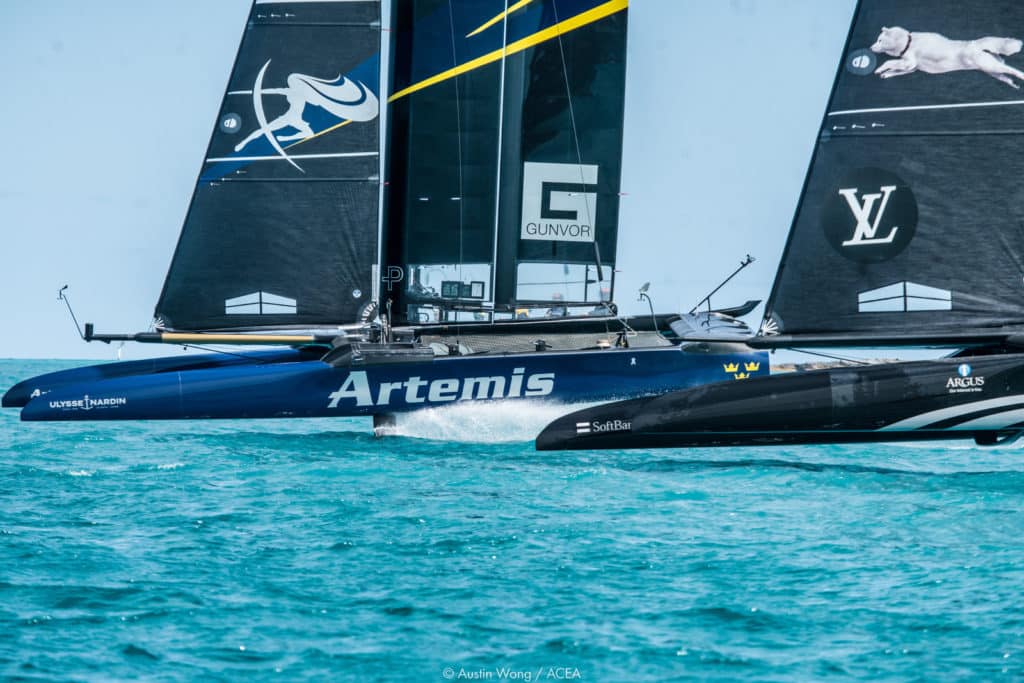
Bermuda’s Great Sound is perhaps the best foiling racetrack in the world — surrounded by a low rim of hills and reefs, the surface is flat and fast. But limited fetch means limited space. The natural boundaries of the Sound are further reduced by America’s Cup Race Management to accommodate the spectator fleet. With a couple of fast foiling catamarans, we now have a claustrophobic racetrack.
In the months leading up to the Cup, my teammates at Oracle Team USA had a few interteam scrimmages, enabling us to understand the likely scenarios we’ll see come May and June. Any time we line up near another boat is a risk, but taking the foot off the gas is unlikely to be our first option. All of the scenarios that follow have happened in real time on the water already in Bermuda. Figuring them out for the first time at 85 to 90 percent of maximum heart rate is not always a recipe for success, but understanding the lead-up and seeing the patterns of behavior of our opponents helped us anticipate and develop our playbook as we get ready for the America’s Cup Match. Each team has its strengths and weaknesses when it comes to configurations and systems, and through debrief, film study and observation, we’ll develop likely playbooks for each team we could see in the first entry, but here are the essentials from our preseason workouts.
01. Controling in the Pre-start
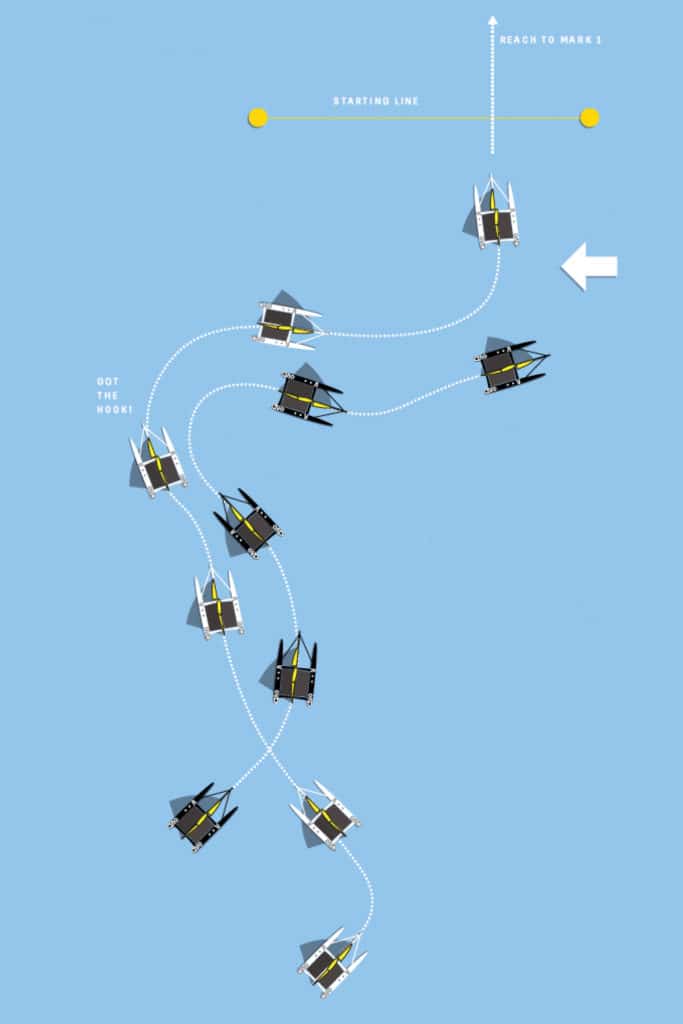
The goal in most America’s Cup match-race starts is to avoid a dial-up. After both boats cross the entry line, there’s a sprint to the deep right edge of the starting box. To best defend its position, the port-entry boat will generally pick a time to lead its opponent back to the starting line. The boat entering on starboard will jibe and trail the port-entry boat into the box, and then wait for it to turn back.
While recovering from its jibe and sailing at max speed, starboard must decide if its opponent is early or late. If they’re late, the countermove is simple: Lead them back to the starting line. If they’re early, the countermove will likely be to sail past the opponent and then turn back and get ready to push. When our opponent is early, they will have to kill time by either sailing extra distance or slowing down. Sailing extra distance upwind puts them at risk of being hooked by a leeward attacker. Sailing extra distance downwind risks losing a high-speed build angle to the start. When early, sailing slower is generally the best option, but positioning to maintain control as the leeward boat can be difficult.
What makes the pre-start especially challenging is that America’s Cup Class catamarans generate a lot of power during the bear-away. Bearing away in displacement mode (hulls in), the leeward bow will load massively, and the boat will surge forward until the boat passes through the power zone and the wing stalls. Once past this point, the boat is safely bow down and has minimized distance away from the starting line.
If the boat is foiling, however, acceleration through the power zone can spike boatspeeds from 15 to 30 knots in a matter of seconds. This is extremely powerful if the pusher is foiling and the leader is not. In this case, the pusher can foil into a hooking position, forcing the leader to try to bear away to retain its leeward position. When doing so, the leader will likely bury its bow and have little chance to defend.
02. Exiting Mark 1
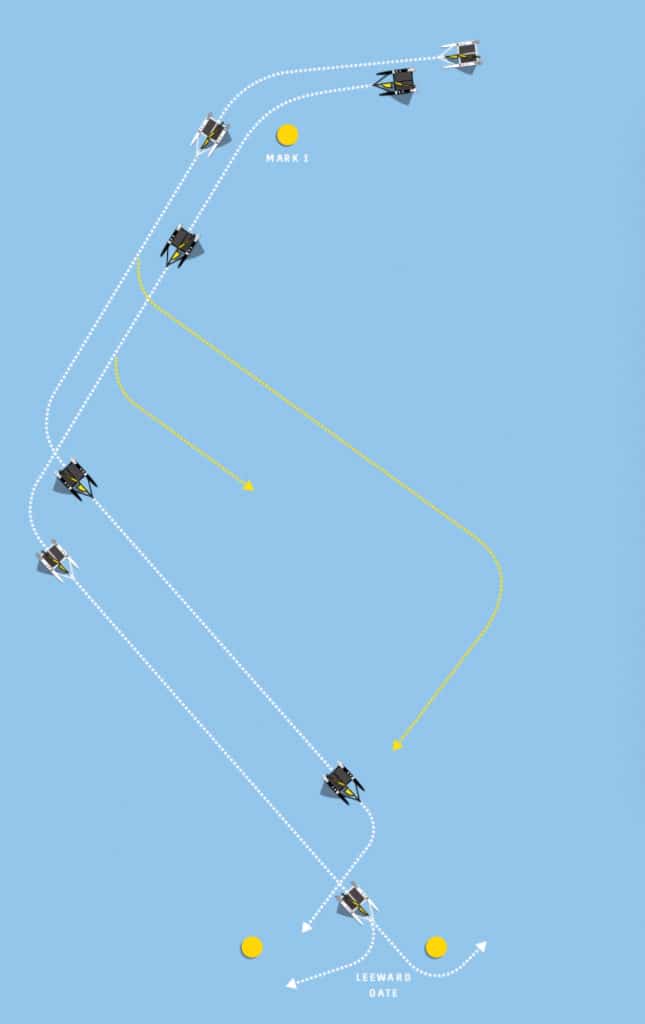
The common scenario from the starting line to Mark 1 is to have one boat leading its opponent bow to stern. After the rounding, the course boundary will quickly come into play — if the layline to the leeward gate doesn’t come first. Here, the trailing boat has an opportunity to attack by dictating the first jibe. If the trailing boat waits until the layline to the first downwind gate, the leader will likely already have jibed, maintaining its leading position. If the trailing boat jibes before the layline, however, the leader has a few interesting options, each with uncertain outcomes. If the trailing boat jibes shy of the port layline, it can force the leader into an uncomfortable decision: Risk another jibe to cover, or take the easy maneuver but give up the split. The leader has two options when the trailing boat jibes: It can simultaneously jibe with the trailing boat, but if it’s late in doing so, it puts itself at risk of being rolled.
If it successfully matches the trailing boat and keeps its air forward, it must then decide whether to sail straight into the left gate, thereby avoiding the risk of another maneuver. Its other choice is to set up for another jibe to guarantee its opponent has to either follow or do a third jibe to split. These decisions must be made after judging the opponent’s and one’s own capabilities. Does the leader have the ability to complete a short jibe before turning upwind at the bottom mark? If the trailing boat must follow the leader around the mark, does the leader have the capability to simultaneously tack and cover? This is where the subtle technical capabilities of each boat (and the collective power output of the grinders) can especially dictate the tactical element of a match.
03. Upwind Boundary Play
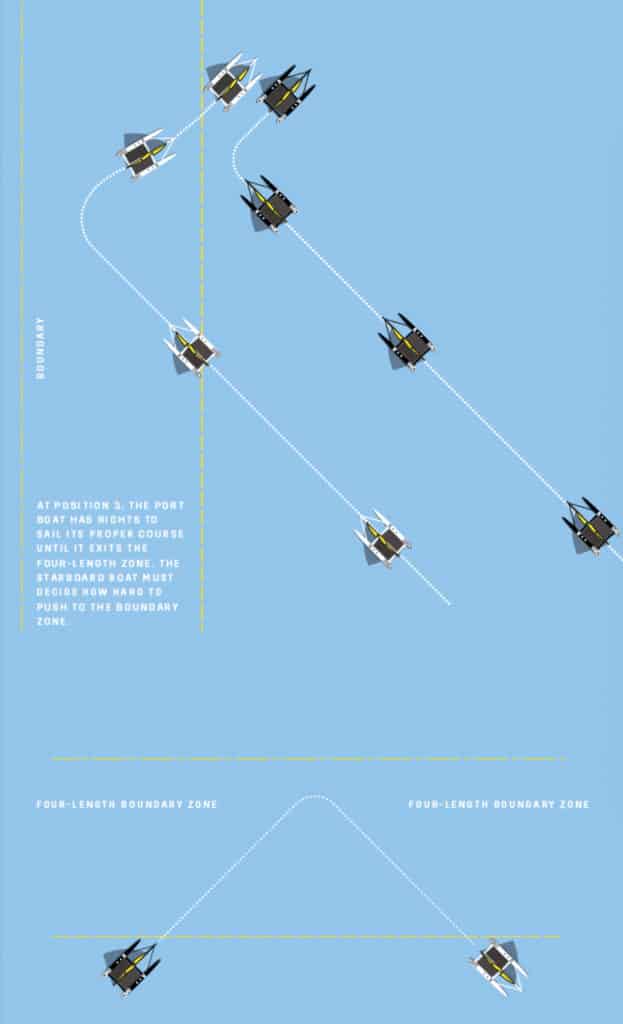
The boundaries of the modern America’s Cup racecourse are designed to keep the racing close, but they also give teams a few race-changing moves. The tactical play here, of course, is to leave the boundary in control. In our diagram, Boat A is closer to the left boundary, approaching on starboard tack. They’re bow out but on the same ladder rung as Boat B, which is locked on their windward hip.
In America’s Cup racing, Rule 20 dictates the ins and outs of the four-length boundary zone. Applying some simple math, we can understand where the best position will be for Boat B to set up on the windward hip and attack. An America’s Cup catamaran, for example, will travel at approximately 25 knots closehauled and 55 degrees from the wind in moderate breeze in Bermuda in June. If the four-length boundary is 200 feet wide, it will take a boat about seven seconds to sail the approximately 250 feet to the boundary. Let’s assume it’s 15 seconds to sail to the boundary wall, tack, and completely exit the boundary zone. When splitting with a boat that’s already on starboard, therefore, whether they’ve crossed or ducked to get to the right, the correct play is to always tack at least 15 seconds after the cross to make sure the next time you meet, when you have the starboard-tack advantage, you’ll be able to take full advantage.
In the situation where starboard is close on the hip, the port boat gains total rights and room to tack onto port and sail its proper course, regardless of any presence of a starboard tacker, until they sail completely out of the zone and her boundary lights turn off. The starboard tacker goes from being in control to being the keep-clear boat, while the boat in the zone is protected by Rule 20.
The windward boat has a couple of options here: It can carefully lee bow to ensure it can affect its opponent while on port tack exiting the boundary. It risks incurring a penalty, however, if it causes its opponent to sail anything other than its proper course. The windward boat could tack early and try to gain on the way across the course in a header or by sailing in a high mode. The low-percentage play is to duck the port-tack boat returning from the boundary, hipping up, and trying to attack at the next boundary.
04. The Upwind Dial-Down
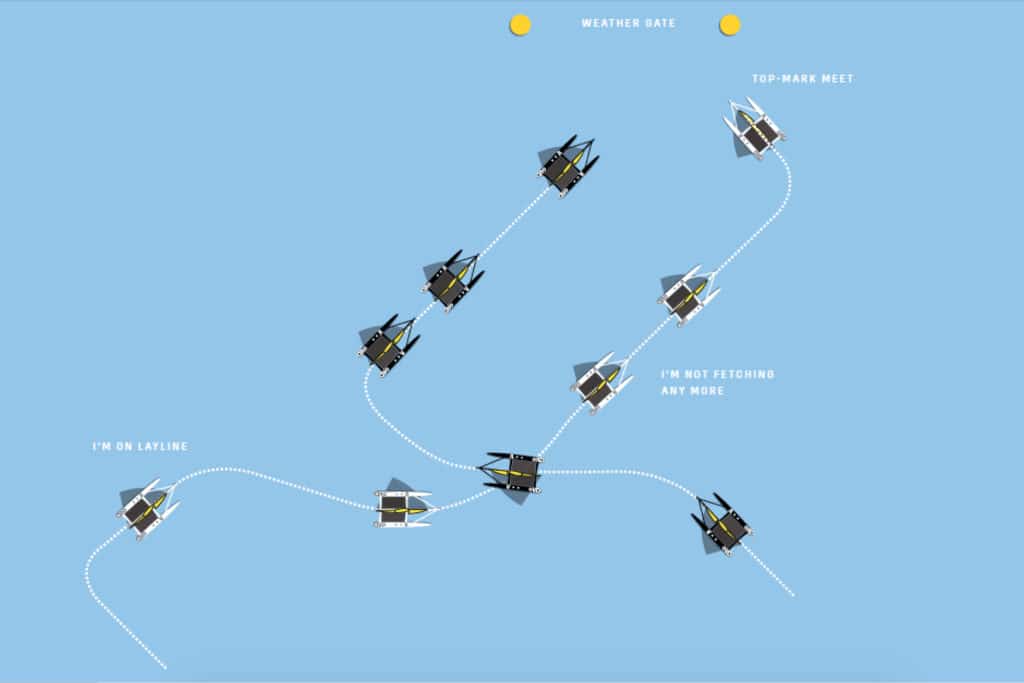
A feature of any match race is the threat of a starboard-tack boat hunting or “dialing down” a port-tack boat to prevent it from having a successful duck. This becomes an especially critical call in and around the port layline to the windward gate.
If the dial-down is done properly, the port-tack boat can be forced below its layline and forced to make a potentially costly and unplanned late tack before the gate. Keep in mind that the starboard tacker is limited by Rule 16.2 to bearing away only 90 degrees from the wind in order to hunt its opponent.
The most successful dial-downs happen when the starboard tacker is only slightly behind. In this scenario, the port tacker must sail more distance downwind in order to duck its opponent. It then has a difficult maneuver getting from downwind, back to upwind, and set up for a tack before being able to attack its opponent again. The port tacker’s best defense is to set up a bit above the port-tack layline so it can both achieve the duck and still lay the mark.
The top-mark gate opens up everybody’s opportunities, but because the foiling catamaran gains so much speed in the duck, the starboard tacker is by no means off the hook if she doesn’t get a penalty in the dial-down. Both boats will burn off speed as they turn up and then tack on their respective laylines, setting up for a close top-mark meet.
05. The Top-Mark Meet
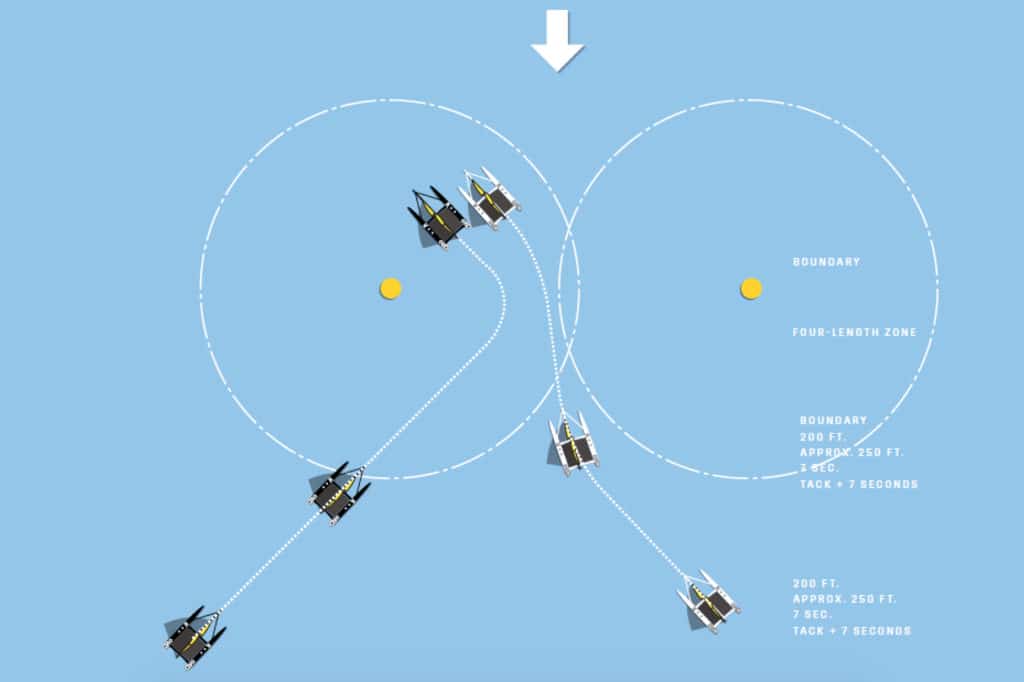
A top-mark meet occurs when a port-tack boat sets up just shy of the layline to the left gate mark, and the starboard-tack boat recognizes it can attack its opponent. Under America’s Cup rules, a boat inside at the zone gains all rights to sail its proper course, so even if starboard puts the bow down to meet port, there is significant risk because, if it meets its opponent after entering the three-boatlength zone at the left gate, Rule 10 turns off and Rule 18 turns on. When port gains rights, it is allowed to sail its proper course, including a normal tack, to round the left mark.
The scenario gets interesting if starboard tacks to leeward once its port opponent has gained zone rights. Now starboard must give the port boat room to round the left gate, but has the right-turn gate to play, with two options in hand. Starboard can press and start to round the new mark on its bow and turn right, but the port boat could follow and try to roll over the top.
Keep in mind, port is likely at full speed while starboard is in a speed-build mode after its tack. Starboard can also luff, forcing its port-tack opponent to make a proper-course tack to round the left mark. Starboard must be careful, however, to allow the port-tack opponent room to make a full-speed tack. Starboard must also then rebuild speed to get down to the right turn and hope that the split will form a starboard-port situation later down the run. Following left is not a good option.
We’re not done yet. Consider when starboard is bow-even and bearing down full speed at port as she gains rights to make a left turn. Foiling catamarans lose a significant amount of speed in the tack, but quite often, the first boat to bear away is going to lead on the exit.
If the port boat can get onto the new tack and successfully bear away on the foils, she will likely lead starboard, even if she has been full speed upwind. If starboard overstands at all, port will have no trouble making a small duck going into the gate, round the right-hand mark, and then be well set up approaching the next cross on starboard downwind.









